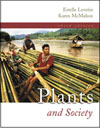
Fungi That Affect Human Health |  |
Chapter Summary1. Among the secondary products produced by some fungi are antibiotics, compounds that are toxic to microorganisms. In the natural environment, these substances provide advantages over competing microorganisms for available nutrients and space. In modern medicine, antibiotics are the primary weapons for fighting bacterial infections. Penicillin was discovered by Alexander Fleming when he examined a culture of bacteria contaminated with Penicillium notatum. Within the next 15 years, purification and mass production of penicillin had been achieved. Although other antibiotics have since been identified and developed, penicillin is still the most widely used antibiotic and is the drug of choice to treat many bacterial infections. Today, antibiotic resistance has been found in many common bacteria, causing major concern among the medical community.
2. Some fungal metabolites are toxic to humans and other animals and capable of causing serious or fatal reactions. These toxins include mycotoxins, which are formed by hyphae of common molds, and mushroom toxins, formed in the fleshy fruiting bodies of basidiomycetes. Mycotoxins are commonly produced by fungi growing in contaminated foods, especially grains and nuts. Aflatoxin was the first mycotoxin identified and studied; today over 200 mycotoxins have been identified.
3. Toxic alkaloids produced by the ergot fungus, Claviceps purpurea, accumulate in the fungal sclerotium on contaminated rye plants. If the sclerotia are harvested and milled along with the grains of rye, contaminated bread results. Throughout the centuries, this has led to outbreaks of ergotism. Although some of the ergot alkaloids are known to have medicinal value, the lysergic acid alkaloids are responsible for hallucinations and other symptoms associated with convulsive ergotism. The hallucinogen LSD was first isolated from these alkaloids.
4. Mushroom toxins are categorized as protoplasmic poisons, neurotoxins, and gastrointestinal irritants. Most fatalities are caused by the protoplasmic poisons known as amatoxins that occur in various species of Amanita as well as other mushrooms. Amanita muscaria, which contains the neurotoxin ibotenic acid, has a long history of use as an intoxicant by native peoples in various parts of the world. Among the tribes of Mexico and Central America, various species of Psilocybe were revered for their hallucinogenic properties. These mushrooms, containing the alkaloids psilocybin and psilocin, have been used for thousands of years in religious and healing rituals.
5. Some fungi affect humans directly by causing superficial or systemic mycoses. Most fungal pathogens cause relatively minor skin infections such as ringworm and yeast infection, but more serious fungal diseases occur in individuals whose immune system is compromised. Histoplasmosis and coccidioidomycosis are two serious systemic infections that occur in North America. Opportunistic infections are caused by a wide range of common saprobic fungi. When the immune system is weakened by drug therapy or disease, infection by these fungi can occur. Invasive fungal infections occur in 25% of these high-risk individuals. The airborne spores of many fungi are known to cause respiratory allergies such as asthma and hay fever. Many of the important allergenic fungi include those whose spores are known to be most abundant in the atmosphere, Cladosporium and Alternaria. Recent concern has focused on the allergenic and toxin-forming fungi proliferating in indoor environments.
|
|
|